Precious Metals
AN IN-DEPTH GUIDE TO GEMSTONE JEWELRY
A diamond cut is a key factor to consider when choosing your next piece of diamond jewelry.
By Chinwe, Chief Creative Officer
Gemstone jewelry has captivated humanity for centuries, enchanting us with its vibrant colors and mesmerizing beauty. In this comprehensive guide, we delve into the world of gemstone jewelry, exploring its definition, historical significance, and the allure of popular gemstones. Gemstone jewelry refers to pieces crafted using precious or semi-precious stones that have been cut, polished, and set into various settings like rings, necklaces, earrings, and bracelets. These stones, also known as gems or jewels, are prized for their rarity, durability, and visual appeal, making them coveted treasures in the world of jewelry. It was used thousands of years ago, by civilizations like the Egyptians, Greeks, and Romans to adorn themselves for symbolic, spiritual, and decorative purposes. Gemstones were believed to possess mystical properties, offering protection, healing, and good fortune to those who wore them. Royalty and nobility throughout history showcased their wealth and power through opulent gemstone jewelry, setting trends that continue to influence modern jewelry designs.
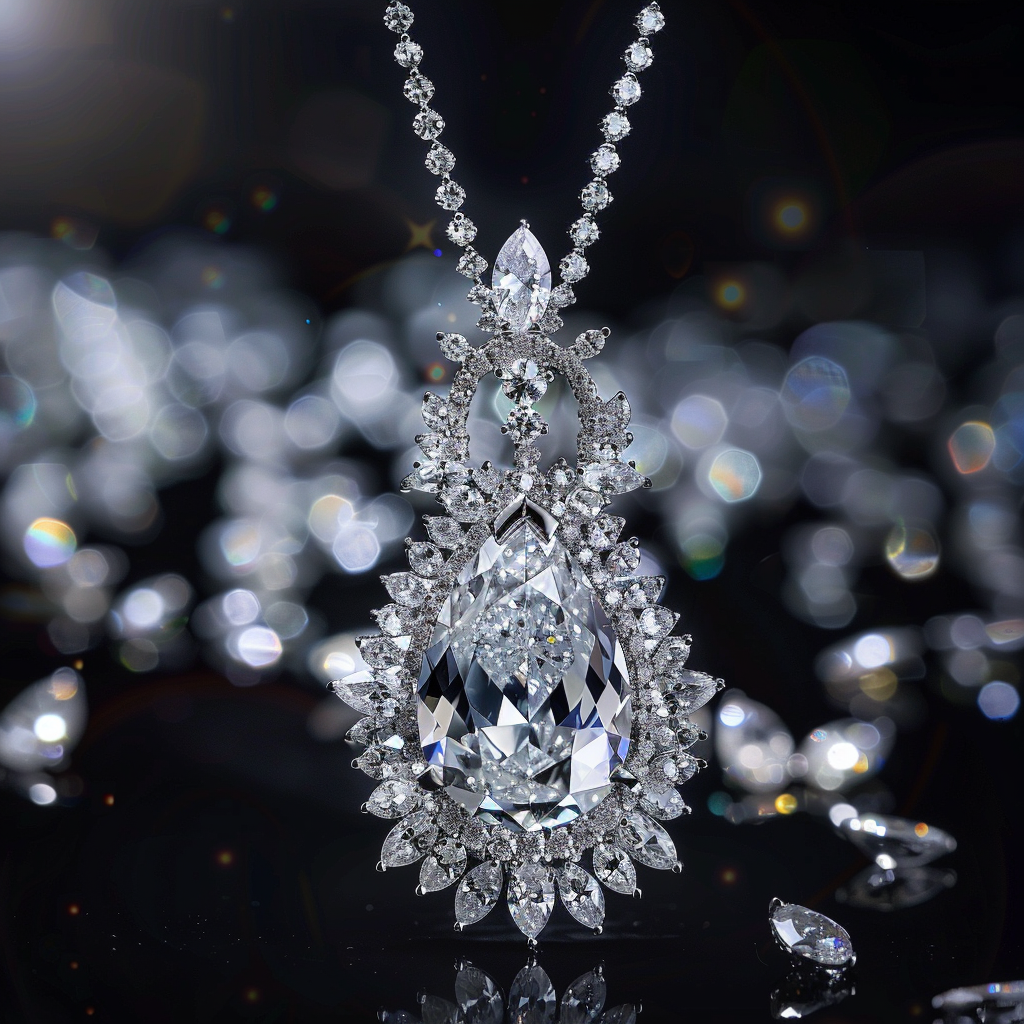
Popular Gemstones
By understanding popular gemstones, you can appreciate the artistry and craftsmanship behind gemstone jewelry and select pieces that resonate with your style and personality.
- Diamonds: Known as the “king of gemstones,” diamonds symbolize everlasting love and are the hardest natural substance on Earth, making them highly prized for engagement rings and luxurious jewelry pieces.
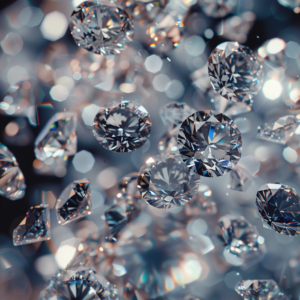
- Sapphires: With their deep blue hues, sapphires represent wisdom, royalty, and divine favor. They are also available in a range of colors like pink, yellow, and green, adding versatility to jewelry designs.

- Rubies: Symbolizing passion and vitality, rubies are prized for their intense red color and exceptional hardness, making them ideal for statement pieces and heirloom jewelry.
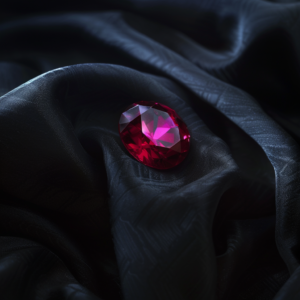
- Emeralds: Representing growth, renewal, and prosperity, emeralds are admired for their lush green color and natural beauty, often featured in elegant and timeless jewelry designs.

- Amethysts: Associated with spirituality and inner peace, amethysts exhibit shades of purple ranging from pale lilac to deep violet, making them popular choices for both casual and formal jewelry.
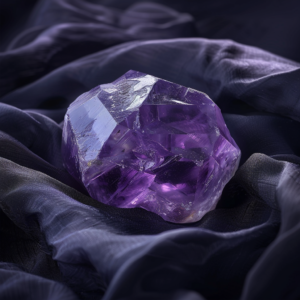
- Aquamarines: Evoking the tranquility of the ocean, aquamarines feature hues of blue and green, symbolizing clarity, serenity, and emotional balance, ideal for delicate and ethereal jewelry pieces.
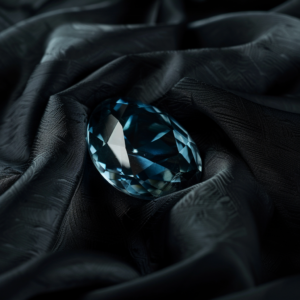
- Opals: Revered for their iridescent play of colors, opals symbolize creativity, inspiration, and imagination, adding a mystical and enchanting touch to jewelry creations.
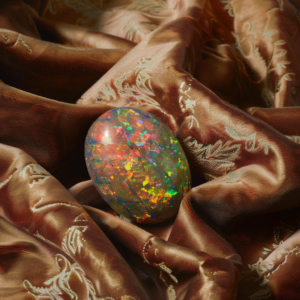
- Pearls: Representing purity, elegance, and sophistication, pearls are unique as they are the only gemstones formed within living organisms, making them timeless classics in jewelry design.

Types of Gemstones
Gemstones are broadly categorized into two main types: precious gemstones and semi-precious gemstones. Each type possesses unique qualities and characteristics that contribute to their appeal and desirability in jewelry design.
A. Precious Gemstones
Diamonds: Known as the ultimate symbol of love and luxury, diamonds are prized for their brilliance, durability, and rarity. These sparkling gems come in various cuts, including round, princess, and emerald, and are often featured in engagement rings, necklaces, and earrings.
Ruby: Symbolizing passion and vitality, rubies are prized for their rich red color and exceptional hardness. These fiery gems add a touch of drama and elegance to jewelry pieces, making them ideal for statement rings and pendants.
Sapphire: With its mesmerizing blue hues, sapphires symbolize wisdom, loyalty, and divine favor. These stunning gems are also available in other colors like pink, yellow, and green, offering versatility in jewelry design.
Emerald: Representing growth, renewal, and prosperity, emeralds are admired for their lush green color and natural beauty. These captivating gems are often featured in vintage-inspired and high-end jewelry creations.
B. Semi-Precious Gemstones
Amethyst: Known for its calming and spiritual properties, amethysts exhibit shades of purple ranging from pale lilac to deep violet. These gems are commonly used in earrings, bracelets, and pendants.
Aquamarine: Evoking the serene colors of the ocean, aquamarines symbolize clarity, harmony, and emotional balance. These gems are popular choices for engagement rings and delicate jewelry pieces.
Citrine: Radiating warmth and positivity, citrines feature vibrant yellow and orange hues. These gems are associated with abundance and joy, making them ideal for adding a pop of color to jewelry designs.
Garnet: With its deep red color reminiscent of pomegranate seeds, garnets symbolize passion, energy, and creativity. These gems are often used in vintage-inspired and bohemian jewelry styles.
Peridot: Known as the “evening emerald,” peridots display a vibrant green color with a hint of golden undertones. These gems are associated with good fortune and vitality, making them popular choices for summer jewelry.
Topaz: Available in a range of colors including blue, pink, and yellow, topaz is known for its clarity and brilliance. These gems are versatile and can be used in both traditional and modern jewelry designs.
Tourmaline: Exhibiting a wide range of colors, tourmalines are prized for their stunning color combinations and unique crystal formations. These gems are used in artistic and one-of-a-kind jewelry creations.
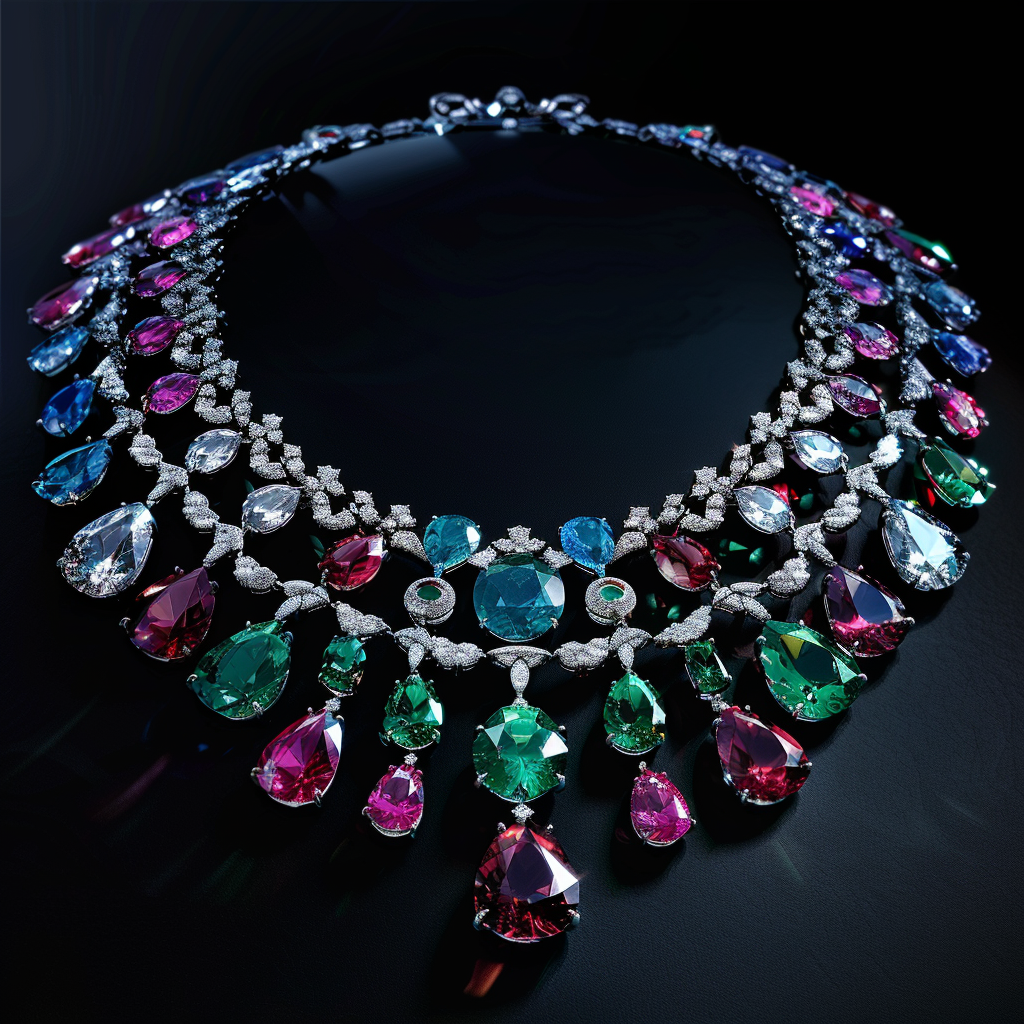
Gemstone Cuts and Shapes
Gemstone cuts play a crucial role in enhancing the beauty and brilliance of a stone. Different cuts and shapes can accentuate the color, clarity, and sparkle of gemstones, creating stunning jewelry pieces that capture the imagination.
A. Round Brilliant Cut
The round brilliant cut is one of the most popular and classic cuts for gemstones, especially diamonds. With 58 facets, this cut maximizes the stone’s brilliance and fire, creating a mesmerizing sparkle that dazzles in any setting.
B. Princess Cut
The princess cut is a square or rectangular cut with sharp corners, offering a modern and elegant look. This cut maximizes the gemstone’s clarity and brilliance, making it a popular choice for engagement rings and contemporary jewelry designs.
C. Emerald Cut
The emerald cut features a rectangular shape with stepped facets that create a hall-of-mirrors effect. This cut highlights the gemstone’s clarity and color, making it ideal for showcasing the beauty of emeralds, as well as diamonds and other gemstones.
D. Oval Cut
The oval cut combines the brilliance of the round cut with the elongated shape, creating a flattering and elegant appearance. This cut is versatile and suits various gemstones, adding a touch of sophistication to rings, pendants, and earrings.
E. Pear Cut
Also known as the teardrop cut, the pear cut features a rounded bottom and a pointed top, resembling a droplet or a pear shape. This cut is versatile and can be set in different orientations, offering a unique and distinctive look to jewelry pieces.
F. Cushion Cut
The cushion cut, also referred to as the pillow cut, has rounded corners and large facets that enhance the gemstone’s brilliance and clarity. This cut adds a vintage and romantic charm to engagement rings and statement jewelry.
G. Marquise Cut
The marquise cut is an elongated cut with pointed ends, creating a graceful and elongating effect on the finger. This cut maximizes the gemstone’s carat weight while showcasing its brilliance and fire, making it a popular choice for solitaire rings and pendants.
H. Heart Cut
The heart cut is a romantic and symbolic shape, representing love and affection. This cut features a heart-shaped outline with facets that enhance the gemstone’s sparkle and brilliance, making it a meaningful choice for special occasions and romantic gifts.
Popular Gemstone Jewelry Styles
Gemstone jewelry encompasses a wide range of styles, each offering a unique allure and appeal. From dazzling rings to enchanting necklaces, earrings, and bracelets, gemstones add a touch of glamour and sophistication to any ensemble.
A. Rings
Engagement Rings: Among the most cherished and symbolic pieces of jewelry, engagement rings feature stunning gemstones that symbolize love and commitment. From classic solitaires to intricate halo designs, gemstone engagement rings are available in a variety of cuts and settings, with diamonds, sapphires, rubies, and emeralds being popular choices.
Cocktail Rings: Bold and glamorous, cocktail rings make a statement with their oversized gemstones and intricate designs. These eye-catching rings are often adorned with colorful gemstones like amethyst, citrine, garnet, and topaz, adding a touch of drama and sophistication to evening attire.
B. Necklaces and Pendants
Gemstone necklaces and pendants are versatile pieces that can elevate any outfit:
Necklaces: From delicate chains with a single gemstone pendant to elaborate designs featuring cascading gemstones, necklaces offer a wide range of options. Popular gemstones for necklaces include turquoise, lapis lazuli, opal, and jade, each adding a pop of color and elegance to the neckline.
Pendants: Gemstone pendants come in various shapes and sizes, from simple teardrops to intricate floral designs. They can be worn on their own or layered with other necklaces for a chic and stylish look.
C. Earrings
Gemstone earrings come in an array of styles, catering to different tastes and occasions:
Stud Earrings: Simple and understated, gemstone stud earrings are perfect for everyday wear. They feature a single gemstone set in a metal bezel, highlighting the stone’s color and brilliance.
Drop Earrings: Elegant and sophisticated, drop earrings feature gemstones that dangle from the earlobe, creating movement and adding a touch of glamour to any outfit. Popular gemstone choices for drop earrings include pearls, amethysts, and peridots.
Hoop Earrings: Versatile and stylish, gemstone hoop earrings feature gemstones set along the hoop, adding color and sparkle to the ears. They can be worn casually or for special occasions, depending on the size and design of the hoops.
D. Bracelets and Bangles
Gemstone bracelets and bangles adorn the wrist with elegance and charm:
Bracelets: Gemstone bracelets come in various styles, from delicate chains with gemstone charms to bold cuffs adorned with multiple gemstones. They can be worn alone as a statement piece or stacked with other bracelets for a layered look.
Bangles: Gemstone bangles are solid bracelets that slip over the wrist, featuring gemstones set along the outer surface. They come in different widths and designs, adding a touch of color and sophistication to any ensemble.
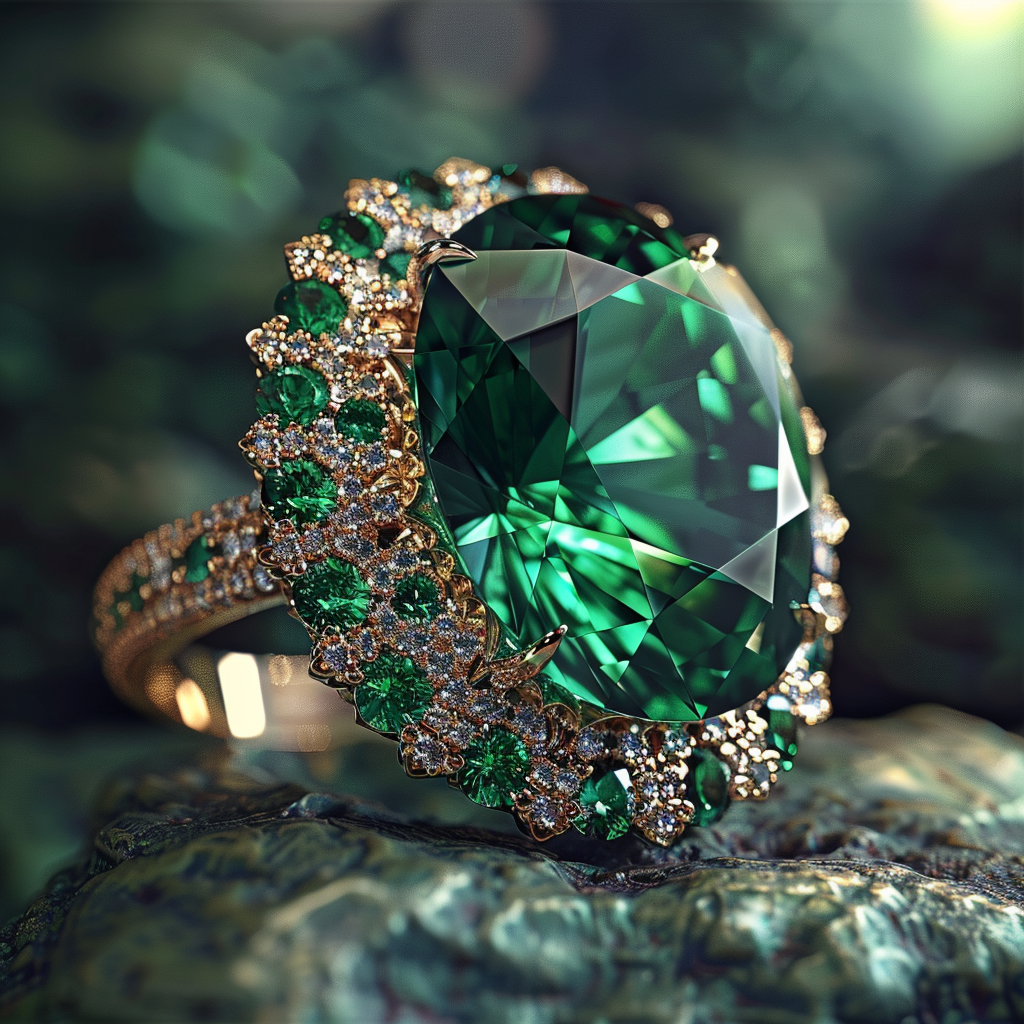
Gemstone Jewelry Settings
Let’s delve into the different gemstone settings commonly used in jewelry craftsmanship:
A. Prong Setting
The prong setting is one of the most traditional and popular settings for gemstones, known for its simplicity and elegance. In this setting, metal prongs or claws hold the gemstone securely in place, allowing maximum light exposure to enhance the stone’s brilliance. Prong settings come in various configurations, including four-prong, six-prong, and multi-prong settings, each offering different levels of security and visibility for the gemstone.
B. Bezel Setting
The bezel setting is a versatile and protective setting where the gemstone is surrounded by a metal rim or collar. This rim holds the gemstone securely in place while providing added protection against impact and wear. Bezel settings can fully or partially encircle the gemstone, offering a sleek and modern look. This setting is ideal for gemstones with delicate edges or for those seeking a more secure setting for everyday wear.
C. Channel Setting
The channel setting is commonly used for accent gemstones or smaller diamonds in jewelry pieces. In this setting, gemstones are placed side by side within a metal channel, creating a seamless and continuous line of stones. The metal walls of the channel hold the gemstones securely in place while allowing maximum light reflection for added sparkle. Channel settings are often used in rings, bracelets, and earrings to create a dazzling effect.
D. Pave Setting
The pave setting is characterized by closely set small gemstones, creating a surface paved with stones. Tiny metal beads or prongs hold each gemstone in place, creating a continuous and shimmering appearance. Pave settings are popular for adding sparkle and texture to jewelry pieces, such as rings, pendants, and earrings. This setting is often used with diamonds or other faceted gemstones to maximize light reflection and brilliance.
E. Tension Setting
The tension setting is a modern and innovative setting that creates the illusion of the gemstone floating between two metal ends without any visible support. The metal ends exert pressure on the gemstone, holding it securely in place. Tension settings offer a contemporary and minimalist look, highlighting the beauty of the gemstone without obstructing its view. This setting is commonly used for showcasing gemstones with unique shapes and colors.
Gemstone Care and Maintenance
Gemstone jewelry, whether adorned with diamonds, rubies, sapphires, or emeralds, requires regular care to maintain its brilliance and luster. Let’s explore the key aspects of gemstone care and maintenance:
A. Cleaning Methods
Warm Soapy Water: For most gemstones, a gentle cleaning with warm, soapy water and a soft brush or cloth is sufficient to remove dirt and oils. Avoid using harsh chemicals or cleaners that may damage the gemstone or its setting.
Professional Cleaning: Periodically, consider taking your gemstone jewelry to a professional jeweler for a thorough cleaning and inspection. They have specialized tools and techniques to clean gemstones safely and effectively.
Avoid Ultrasonic Cleaners: While ultrasonic cleaners are effective for some jewelry, they can be too harsh for certain gemstones, causing fractures or damage. Consult with a jeweler before using ultrasonic cleaners.
B. Storage Tips
Separate Storage: Store each piece of gemstone jewelry separately to prevent scratches and damage from contact with other jewelry items. Use soft pouches, jewelry boxes with individual compartments, or lined jewelry trays for storage.
Avoid Exposure: Keep gemstone jewelry away from direct sunlight, extreme temperatures, and chemicals like perfume, hairspray, or household cleaners. Prolonged exposure to these elements can fade or damage gemstones.
Regular Inspections: Periodically inspect your gemstone jewelry for loose stones, worn prongs, or signs of damage. Promptly address any issues by taking the jewelry to a professional jeweler for repairs.
C. Avoiding Common Mistakes
Wearing During Activities: Avoid wearing gemstone jewelry during activities that may expose it to potential damage, such as sports, gardening, or heavy lifting. Remove jewelry before engaging in such activities to prevent accidents or damage.
Improper Storage: Avoid storing gemstone jewelry in humid or damp environments, as moisture can damage certain gemstones and metal settings over time. Store jewelry in a cool, dry place to maintain its condition.
Overexposure to Chemicals: Be cautious when wearing gemstone jewelry around chemicals, including household cleaners, chlorine, and beauty products. Chemical exposure can dull or discolor gemstones and erode metal settings.
Ethical Sourcing and Sustainability in Gemstone Jewelry
As consumers become more conscious of ethical and sustainable practices, the gemstone jewelry industry has seen a shift towards ethical sourcing and sustainability. Let’s explore the key aspects of ethical sourcing and sustainability in gemstone jewelry:
A. Conflict-Free Diamonds
Certified Diamonds: Look for diamonds certified by reputable organizations like the Kimberley Process Certification Scheme (KPCS) to ensure they are conflict-free and ethically sourced. These certifications guarantee that diamonds are not mined in conflict zones or used to fund armed conflicts.
Traceability: Opt for jewelers and brands that provide transparency about the diamond’s origin, ensuring it comes from ethical and responsible mining practices. Traceability allows consumers to make informed choices and support ethical sourcing in the diamond industry.
B. Fair Trade Gemstones
Fair Trade Certification: Consider gemstones with Fair Trade certification, indicating they were mined, cut, and traded under fair labor conditions. Fair Trade practices promote social responsibility, fair wages, and safe working environments for miners and artisans.
Supporting Communities: Purchasing Fair Trade gemstones supports local communities in gemstone mining regions by providing economic opportunities, education, and healthcare initiatives. It ensures that miners and workers receive fair compensation and benefits from their labor.
C. Eco-Friendly Practices
Recycled Metals: Choose jewelry made from recycled metals, such as recycled gold or silver, to reduce environmental impact and minimize the need for new mining. Recycled metals contribute to sustainable practices and resource conservation in the jewelry industry.
Sustainable Gemstone Mining: Look for gemstones sourced from environmentally responsible mining practices that prioritize conservation, land reclamation, and minimizing ecological footprint. Sustainable mining aims to protect ecosystems, wildlife habitats, and natural resources.
Eco-Friendly Production: Seek jewelry brands and designers that follow eco-friendly production methods, such as using renewable energy, reducing waste and emissions, and implementing ethical supply chain practices. Eco-friendly production contributes to overall sustainability in the gemstone jewelry industry.
Factors Affecting Gemstone Value
Investing in gemstone jewelry can be both a passion and a financial opportunity. Here are the key aspects to consider when investing in gemstone jewelry:
1. Gemstone Rarity: Rare gemstones with limited availability, such as certain colored diamonds, alexandrite, and Paraiba tourmaline, often command higher prices due to their scarcity in nature.
2. Gemstone Quality: The quality factors that influence gemstone value include color intensity, clarity, cut precision, and carat weight. Higher-quality gemstones with vibrant colors, minimal inclusions, excellent cuts, and substantial carat weights tend to have greater value.
3. Gemstone Origin: Gemstones sourced from renowned regions known for producing exceptional quality stones, such as Kashmir for sapphires or Colombia for emeralds, can have higher value due to their geographic uniqueness and mining heritage.
4. Gemstone Treatments: Disclosure of gemstone treatments, such as heat treatment or enhancement, can impact value. Natural, untreated gemstones often hold higher value and appeal to collectors and investors.
Investment Potential of Certain Gemstones
1. Colored Diamonds: Rare colored diamonds, including pink, blue, and green diamonds, have demonstrated strong investment potential, with prices steadily increasing over time due to their scarcity and desirability among collectors.
2. Colored Gemstones: Certain colored gemstones, such as vivid red rubies, intense blue sapphires, and vibrant emeralds, can also be valuable investments when they exhibit exceptional color saturation, clarity, and size.
3. Historically Significant Gemstones: Gemstones with historical significance or celebrity provenance, such as the Hope Diamond or Elizabeth Taylor’s jewelry collection, can attract collectors and fetch premium prices at auctions and sales.
Gemstone Jewelry Trends
Gemstone jewelry trends evolve with changing consumer preferences and fashion influences. Here are some current and emerging trends in gemstone jewelry:
1. Vintage-Inspired Designs: Jewelry pieces featuring vintage-inspired designs, such as Art Deco motifs, Victorian styles, and retro aesthetics, are gaining popularity among collectors and fashion enthusiasts.
2. Ethnic and Cultural Influences: Gemstone jewelry reflecting ethnic and cultural influences, including tribal motifs, ethnic patterns, and indigenous gemstone choices, resonate with consumers seeking unique and meaningful jewelry pieces.
3. Customization and Personalization: The trend of personalized gemstone jewelry, such as birthstone jewelry, custom-designed pieces, and engraved gemstones, continues to thrive as individuals seek to express their individuality and style preferences.
4. Sustainable and Ethical Jewelry: Increasing awareness of ethical and sustainable practices has led to a rise in demand for responsibly sourced gemstone jewelry, eco-friendly designs, and brands committed to ethical production methods.
the in-depth guide to gemstone jewelry serves as a valuable resource for those passionate about gemstones, from collectors seeking rare treasures to investors exploring the potential of these timeless assets. With careful attention to quality, authenticity, and market trends, gemstone jewelry remains a timeless symbol of beauty, heritage, and investment value in the ever-evolving world of luxury adornments.

